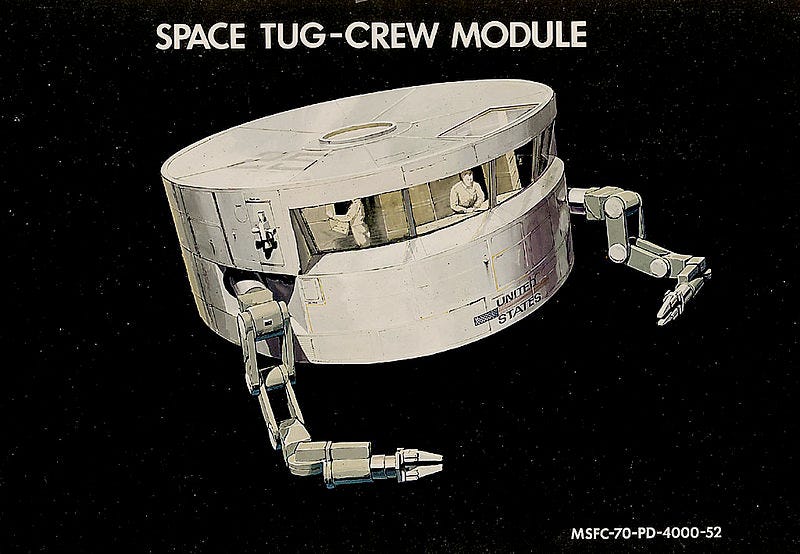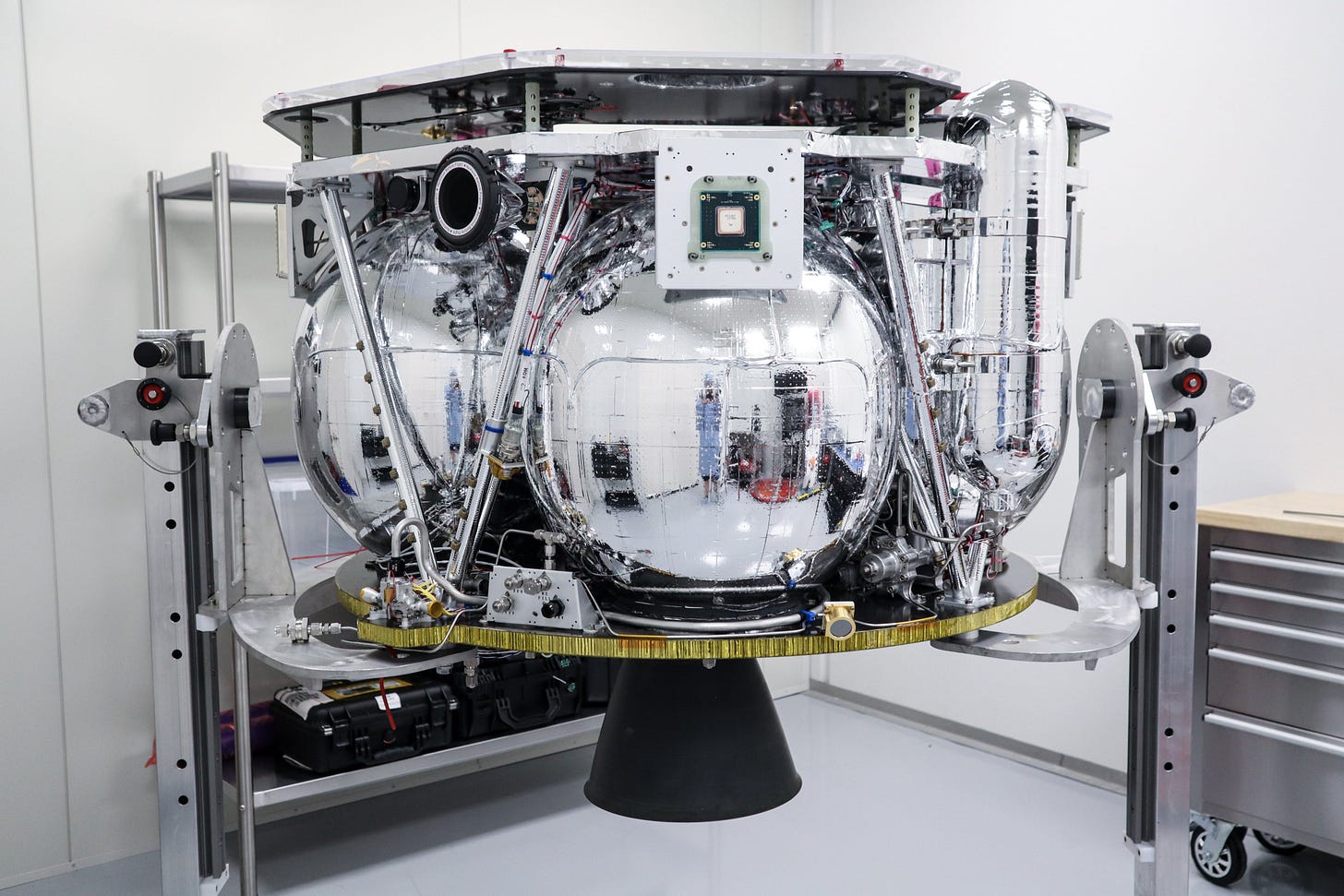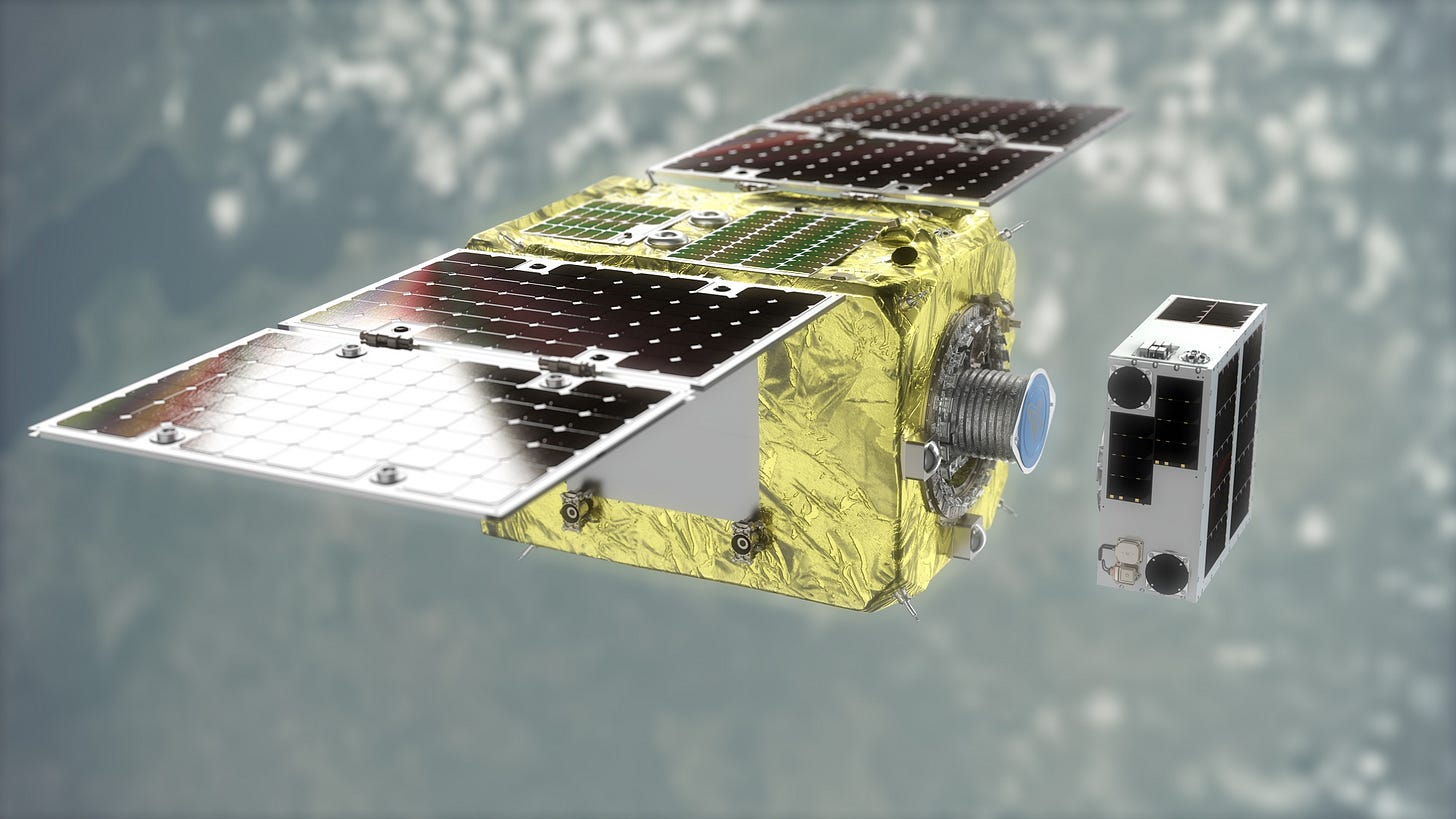Tyranny of the Rocket Equation
When a rocket launches from the Earth’s surface, its physics are largely guided by the famous Tsiolkovsky Rocket Equation. Seen below, the equation measures how much “delta-V” or change in velocity a rocket can achieve. To maximize this delta-V, rockets are built to be as powerful, yet lightweight as possible, focusing on the “m” variables or “Mass Fraction” which relates the mass of vehicle at takeoff and with its final mass once the payload is deployed.
There are various orbits around the Earth that we send satellites to for various reasons. Low Earth Orbit or LEO (<2000km from Earth) is the closest and most accessible orbit, which explains why over 80% of active satellites reside there. Then comes Medium Earth Orbit (2000km to 35,786km) where our GPS satellites live. This is followed by Geosynchronous Orbit at 35,786km where satellites orbit the Earth at the same rate as Earth rotates, a unique satisfying relationship that allows us to monitor specific spots on the globe at all times. To successfully reach each of these orbits, rockets and their satellite payloads must generate a specific amount of delta-V.
The ultimate goal of a rocket is to carry as much useful mass to the proper orbit as possible and, thanks to Tsiolkovsky’s pesky math problem, there are only a few ways to optimize the equation. Launch companies and satellite operators have three options to achieve this:
Use a bigger, more efficient rocket
Fly a smaller satellite
Reuse spacecraft on orbit
As you can see from the chart above. It requires significantly more delta-V to get to higher orbits. As you have probably read, companies like SpaceX and Blue Origin are already building massive rockets to significantly bring down the “per kilogram” cost to orbit but trying to achieve improved performance from the rocket alone eventually becomes both technologically and economically undesirable. In conjunction, satellites have continued to downsize over the past two decades. But with smaller satellites often comes decreased capabilities. So how do you optimize for mass without sacrificing performance? That’s where option 3 and Space Tugs come into play. If you can take a significant portion of the mass typically necessary on a satellite or rocket upper stage (think propellant, thrusters, star trackers, mechanisms, etc.) and move them to a secondary vehicle that docks and moves around the primary satellite, you can drive noteworthy innovation that may be currently restricted by Earth’s gravity well.
What’s a Space Tug?
Originally envisioned in sci-fi lore as far back as the 1950’s, a space tug is a spacecraft whose sole purpose is to manipulate other satellites. Space tugs are built with a propulsion system and the ability to either carry or rendezvous with other spacecraft. Once adjoined with another spacecraft, the space tug is tasked performing a myriad of operations. This can include moving the primary spacecraft to its desired final orbit, repairing a faulty satellite, or even de-orbiting a dead satellite. In the first scenario, by utilizing a space tug, the delta-V requirements to reach higher energy orbits are partially transferred from the rocket to the space tug system. This allows rockets to carry satellites to LEO (the lowest-energy requirement) before handing off energy requirements to the space tug.
Over the past seven decades, plans for space tugs have followed various form factors and end use cases. In the 1970’s, NASA began studies on the Space Transportation System (STS), an architecture meant to build on the Apollo program and create a sustained presence in space. The program detailed an Earth-to-Space Shuttle (which, known as the Space Shuttle, would be the only piece to survive NASA budget cuts), a 2 to 5 person habitat, a space tug for assembly and operations in-space, and a nuclear-powered NERVA shuttle to take astronauts to the Moon and beyond.
While most of the program was sadly scrapped, studies on the space tug continued through the 1980’s, once the Shuttle was successfully flying. Several large prime contractors pitched their Orbital Transfer Vehicles (Martin, Boeing) and Orbital Maneuvering Vehicles (TRW) for various missions involving crew and cargo transport or robotic servicing of instruments like the Hubble Space Telescope. Despite millions of dollars dedicated to study these contracts from 1984 to 1989, each was eventually cancelled due to cost overruns.
Going the Extra Mile
While early space tug concepts focused on maneuvering large orbital structures such as space stations or solar arrays, today’s vehicles are focused on a variety of mission sets. With the resurgence of commercial space launch and the miniaturization of satellites over the last decade, a new set of functionalities is required for in-space operations.
Now, thousands of satellites are launched each year and while most are still destined for Low Earth Orbit, many still need an extra boost to their preferred orbital destinations. Larger legacy satellites may need a tuneup after years on orbit. Others still may need to get out of the way once they near the end of their life. To meet the rising challenges that accompany the growth of the commercial satellite industry, several space tug providers are hoping to invigorate an in-space ecosystem with mission-specific applications and technological advancements.
Space Tugs that Dispense
On December 3, 2018, a Falcon 9 rocket launched from Vandenberg Air Force Base carrying a “third stage” payload. In the fairing sat a payload dispenser known as SHERPA, built by Spaceflight Inc. After deploying the SHERPA spacecraft to a Sun Synchronous Orbit, the Falcon 9 first stage returned to Earth and landed on a drone ship. The SHERPA went on to deploy over 70 small satellite payloads from 18 countries to distinct orbital locations. Three years later, Spaceflight would launch an upgraded SHERPA with a xenon thruster capable of moving hosted payloads to ensure an even more precise final location.
Seeing Spaceflight’s success and the increasing demand for accurate small satellite deployment, a barrage of new “dispenser” space tug companies emerged. After launching their Electron rocket thirteen times, Rocket Lab introduced the Photon spacecraft which serves as a payload bus for the rocket and provides customers with additional in-space propulsion to reach their final desired orbits. Other launch vehicle companies like Firefly, Launcher, and Skyrora followed suit by announcing their own orbital transfer vehicles to create a full “space logistics” product chain. Startups like ExoLaunch and D-Orbit out of Europe have successfully deployed satellites from their rideshare containers and are now turning towards developing increasingly advanced space tugs to improve the range of orbits that they can service for their customers. Though not exactly aligned with the classic version of a space tug (which deploys as a separate vehicle), this modern “dispenser” space tug has become increasingly common and economically viable. Over time, we may see these dispensers develop more sophisticated subsystems that allow for additional on-orbit operations.
Space Tugs that Diagnose
The second cohort of space tugs follows a more traditional definition of the term. These vehicles launch as standalone spacecraft with a full suite of propulsion, power, GNC, and mechanical interfaces meant to rendezvous with existing satellites on-orbit before performing a specific set of operations. This can include fixing a broken solar panel, refueling, helping course correct, or moving the satellite to a new orbit.
There are several companies vying to build the premier in-space “handyman” business. Prime contractor Northrop Grumman has had the most tangible success with its Mission Extension Vehicle (MEV) program. First launched in 2019, the MEV is a small-scale, in-space refueling spacecraft designed to dock with existing space assets to prolong their functional life. The initial concept was designed in 2011 by Vivisat, a joint venture between US Space and ATK, which became Orbital ATK, which became Northrop Grumman Space Systems, which became…(you get the point). In 2019, Northrop’s MEV-1 mission successfully docked with the Intelsat 901 satellite and telerobotically repositioned the satellite to improve its performance and extend its “useful” life for up to 5 years (providing one of the coolest space GIFs of all time). The following year, MEV-2 docked with Intelsat 10-02 in a geostationary orbit and helped reposition the wayward satellite.
Perhaps the most intriguing of the space tug companies (and the only one that took part in the 2021 Space SPAC Madness) is Momentus. Founded by Russian entrepreneurs Mikhail Kokorich and Lev Hasis, Momentus aims to design a suite of space tugs that provide satellite operators access to power, communications, and station keeping to allow for changes in orbital inclination and plane. Starting with their Vigoride spacecraft, which is now set to launch in 2022, Momentus hopes to offer a dispenser-like operation before moving into upgraded versions of Vigoride (and the larger Ardoride and Fervoride) which will provide in-space operations such as refueling, docking, repair, and inspection.
As a company, Momentus has had a rocky journey after filing to go public via SPAC in 2020. Initially, they had to overcome a battle with the SEC on claims that they mislead investors on their water-based microwave propulsion system. Then, the U.S. Defense and Treasury departments forced Kokorich and Hasis to sell their portions of Momentus due to geopolitical conflicts stemming from their Russian lineage. Despite these setbacks, Momentus now seems to be back on track and has booked several SpaceX Falcon 9 rockets for the coming years to launch their preliminary Vigoride missions.
Several smaller startups have joined the space tug race in recent years. Based out of Denver, Atomos is looking to build an orbital transfer vehicle to rendezvous with satellites in orbit and help move them to a preferred plane or inclination. Starfish Space out of Seattle is building a space tug with autonomous docking software to help refuel, repair, and remove satellites. Industry veterans like early SpaceX engineer Tom Mueller (Impulse Space) and former Momentus CTO Joel Sercel (TransAstra) have entered the space tug game looking to build on their decades of commercial space experience.
Companies are also looking to commercialize the space-tug-enabled cislunar economy by creating services that will ease complicated on-orbit processes such as docking and refueling. SCOUT is developing optical instruments that can easily integrate into existing satellite platforms to assist in the complex visual environments necessary for observation of other spacecraft. Orbit Fab is designing “Gas Stations” in space for on-orbit refueling. They are also working to standardize docking ports on satellites to simplify future refueling missions. Companies like MDA, Altius Space Machines, and Motiv Space Systems are focused on the robotic arms and interfaces necessary for capture and manipulation of spacecraft in orbit. As lower launch costs continue to promote creativity on-orbit, a new tranche of commercial space companies are emerging to build the future economy in LEO and beyond.
Space Tugs that Declutter
There is another class of spacecraft that may fall into the space tug category but rather than keeping satellites in orbit, they work to bring dead or dangerous satellites safely back to Earth’s atmosphere. In recent years the term “space debris” has made waves within the media, government, DoD, and commercial space companies. As more satellites launch, the habitable zones for these assets become cluttered. Despite best efforts from civil, military, and commercial operators, some satellites fail. A dead satellite runs the risk of colliding with other spacecraft and leading to a cascading effect of debris, known as Kessler Syndrome. To avoid this catastrophic scenario, several companies are focused on capturing and deorbiting dangerous space objects.
The leader in this effort is Astroscale, who launched their ELSA-d demonstrator mission in 2021. ELSA-d was deployed with two distinct spacecraft, a “servicer” and a “client”, both equipped with electromagnetic docking systems. The spacecrafts successfully demonstrated orbital debris capture techniques in August of 2021 and Astroscale is still working through various capture procedures on orbit. Astroscale plans to launch their first active debris removal missions, ADRAS-J, in 2023 on a Rocket Lab Electron vehicle, which will attempt to analyze a Japanese rocket upper stage that is tumbling in orbit. Through their partnership with JAXA, Astroscale hopes to then launch a follow on mission to formally capture and deorbit the rocket remains.
There are additional entrants into the active debris removal arena, like ClearSpace and Orbuta, who are building small spacecraft to fight Kessler Syndrome. Even more popular are the analysis and identification companies, like LeoLabs and Privateer (founded by Apple’s Steve Wozniak), hoping to improve detection and cataloguing of the innumerable objects orbiting the Earth. Despite the clear societal and logistical challenges associated with orbital debris, it will be fascinating to see how the business case develops with new incentives arising for commercial capabilities from the Space Force, Air Force, and intergovernmental agencies.
What’s Next?
As SpaceX led the charge to launch and landing rockets, it became cheaper and more accessible to send something to space. However, despite Elon’s best efforts, there is still a natural barrier between the Earth and even our closest stable orbits. Tsiolkovsky’s rocket equation puts restrictions on the amount of mass we can send to space and, once there, satellites are essentially inaccessible. Space tugs are hoping to change this by both taking advantage of the improved launch economics and unleashing the often talked about “cislunar economy”. By providing architectures for refueling, repair, and orbital adjustments, space tugs allow for increased operational capabilities for essentially all satellite operators, big and small. Though mostly still in their nascent stages, space tug companies are working to mature and standardize what it means to work in-space. If all goes according to plan, we will hopefully see a bevy of branded “space taxis” in the coming years that can swiftly fly over to help fix a broken sensor, provide some much needed fuel, or push a satellite to a new orbit before zipping off to assist their next happy customer.
















Great post Simon!